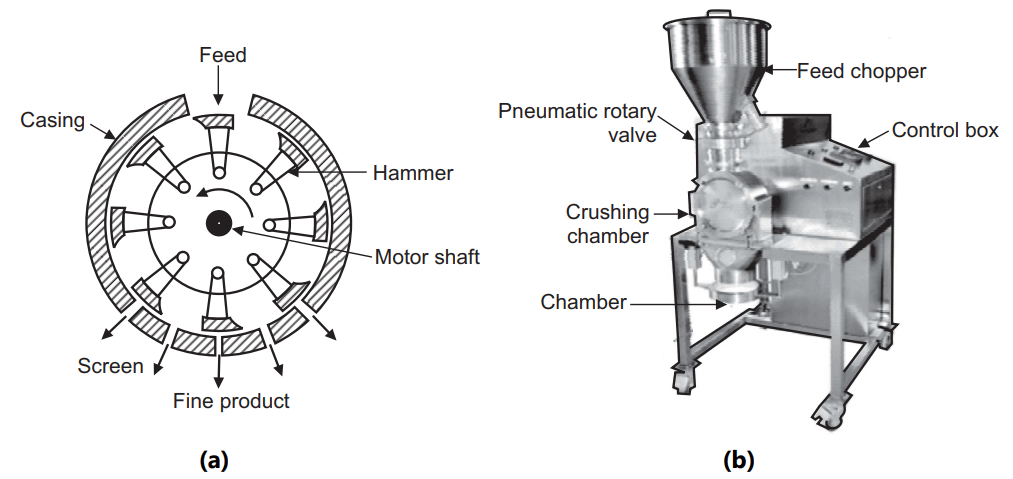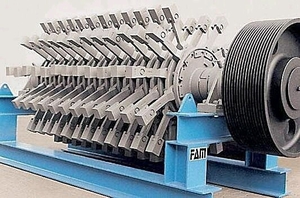In the pharmaceutical and food processing industries, a hammer mill is a necessary machine. It can crush, pulverise, shred, grind, and reduce material to appropriate sizes. Swinging hammer heads are coupled to a rotor that revolves at a high speed inside a rigid casing in a hammer mill.
Table of Contents
Principle of hammer mill
The hammer mill’s functioning principle is straightforward. Fig. 2.2 illustrates the principle (a). All that is required is the selection of a suitable engine, crushing hammers/knives, and the material to be crushed. It works on the basis of impact between the rotor’s fast-moving hammers and the stationary powder bed. Between the hammers and the casing, the material is crushed and pulverised, and it stays in the mill until it is fine enough to pass through a sieve at the bottom of the casing. Hammer mills can handle both brittle and fibrous materials, while fibrous materials may require projecting parts on the casing to provide a cutting motion.
Construction of hammer mill
There are five essential pieces to a hammer mill. Figure 2.2 depicts a fully built pharmaceutical hammer mill (b). Depending on the intricacy of the machine design, the number of pieces may vary. Every component of a hammer mill contributes to the overall operation of the machine. The milling process, on the other hand, takes place mostly in the crushing chamber. It is made up of a sturdy steel case with a central shaft and four or more swinging hammers attached to it. The hammers swing out to a radial position when the shaft is rotated by the engine.
A sieve of the desired size is fitted to the lower half of the casing and may be readily replaced depending on the particle size required. Between the hammers and the casing, the material is crushed and pulverised, and it stays in the mill until it is fine enough to pass through a sieve. If fibrous materials are to be treated, some mills have protruding parts on the casing that provide a cutting motion. Hammer mills come in a variety of sizes, styles, and shapes. They are used in the pharmaceutical sector to grind dry materials, wet filter cakes, ointments, and slurries, among other things.

Working of hammer mill
The feeding mechanism refers to the process by which particles enter the crushing chamber. Depending on the design of the hammer in the mill machine, it may use either gravity or a metered feeding system. Metered feeding systems are used when product uniformity is a major concern as they eliminate all possible variables that may cause output product inconsistencies. A good example, in this case, is the pneumatic rotary valve found between the feeding hopper and the crushing chamber. In the gravity feeding system, the milling machines solely depend on the gravitational force that helps to feed particles into the crushing chamber.
The control box allows users to turn the machine on and off. The feeding system and motor speed can both be controlled by the operator. A display panel is available on some pharmaceutical milling machines, allowing users to keep track of all processes. This mill runs at a high speed, ranging from 2,500 to 60,000 revolutions per minute. Hammers are usually installed on horizontal shafts and can rotate either clockwise or counterclockwise. This could be affected by the rotor’s rotational direction.
This could be affected by the rotor’s rotational direction. The revolving shaft connected to an electric motor is known as a rotor. The hammers are available in a variety of forms and shapes. Crushing tools in a hammer mill might be directly connected to a motor or operated by a belt. Unlike direct connections, belts can protect the motor from shock and allow for precise speed control. A pharmaceutical hammer mill’s output varies greatly. Normally, particle size is determined by sieve variation. Over 12 distinct types of sieve meshes may be found in these hammer mills. The revolving hammers reduce pharmaceutical ingredients that enter the systems to very small particles.
The basic working steps are as follows:
(i) Introducing material through the feed hopper:
Materials with suitable physical properties that have been cut to the right size are selected. Depending on the design
of the hammer mill it will move into the crushing chamber either by gravity or controlled/metered process.
(ii) In the crushing chamber:
The material was repeatedly struck by ganged hammers or chopping knives. These components spin at a high rate, reducing materials to the size required. Only particles of the same dimension as the sieve size pass through sieves. Otherwise, the hammers will continue to pound these materials until they reach the desired size. Essentially, the material is attacked by a repetitive mix of knives/hammer impact and contact with the milling chamber’s wall within this chamber. Furthermore, particle collisions play an important role in the size reduction process. It is not recommended that the crushing chamber be opened while the machine is running.
(iii) Outlet of the milling chamber:
Perforated metal sieves line the milling chamber’s exit (bar gates). The metal sieve permits the needed size of particles to pass through while keeping coarse material, depending on its size and design. The material that passes through is essentially the final product, which is referred to as output.
Factors determining output and capacity of hammer mill:
The particle size of a hammer mill is largely determined by three factors. The hammer or cutting knife configuration, shaft speed, and sieve size are among them. When big particles are reduced to small sizes, the outcome is usually a fine or coarse finish. Size, a high spinning rotor speed, a tiny sieve size, and large or/and more crushing knives/hammers are recommended to achieve fine particles. Few or/and small crushing hammers/knives, slow rotor speed, and large sieve are critical elements for coarse finished output.
Merits of hammer mill
- It is rapid in action, and is capable of grinding many different types of materials.
- They are easy to install and operate, the operation is continuous.
- There is little contamination of the product with metal abraded from the mill as no surface move against each other.
- The particle size of the material can be easily controlled by changing the speed of the
- rotor, hammer type, shape and size of the sieve.
Demerits of hammer mill
- The high speed of operation causes the generation of heat that may affect thermolabile materials or drugs containing gum, fat, or resin. The mill may be water-cooled to reduce this heat damage.
- The rate of feed must be controlled carefully as the mill may be choked, resulting in decreased efficiency or even damage.
- Because of the high speed of operation, the hammer mill is susceptible to damage by foreign objects such as stones or metal in the feed. Magnets may be used to remove iron, but the feed must be checked visually for any other contamination.
Uses of hammer mill
- Fibrous materials can be handled in hammer mills by cutting edges.
- Brittle material is best fractured by impact of blunt hammers.
- It is capable of producing intermediate grades of powders of almost all substances.
- Powdering of barks, leaves, roots, crystals and filter cakes.
- Useful for granulation where the damp mass is cut in to granules by the hammers.
Also read: Mechanism of size reduction
